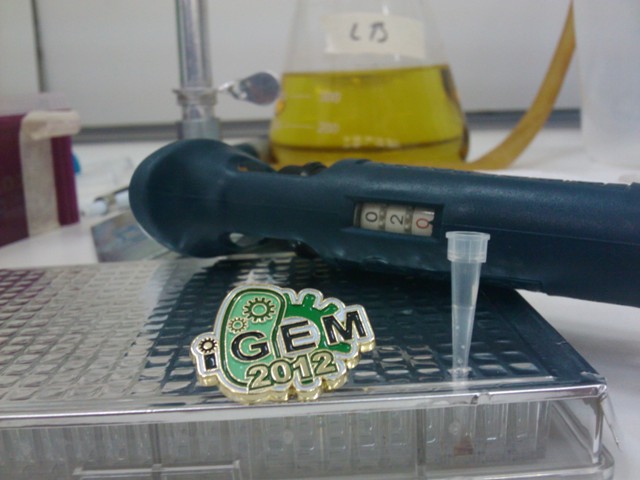Team:Buenos Aires/Results/Cloning
From 2012.igem.org

Cloning and Transformation
Because we didn’t receive the pSB1C3 plasmid (tube received in the kit containing plasmid was dry and we couldn’t get any mass), we took the BioBrick BBa_J04450 (Plate 1, position A3) from the kit and transformed CaCl2-competent cells (E. coli strain DH5α) following a heat-shock protocol, and cells were plated on LB-agar containing Chloranphenicol.
Over-night red colonies (the BioBrick contains a device that expresses RFP, that’s the reason we used this part!) were used for liquid cultures (LB + Chloranphenicol). Minipreps of pSB1C3 were done using the AxyPrep Plasmid Miniprep Kit (Axygen).
The obtained plasmid was cut using EcoRI and PstI restriction enzymes (both from Invitrogen) at 37 °C for 1 hour. We performed a preparative 1%-agarose gel with the product of the reaction, and the pSB1C3 backbone was purified from its respective band (in relation with 1 Kb-DNA ladder marker) through a commercial kit.
After a lot of time spent in cloning and troubleshooting, we accomplished the ligation of devices into pSB1C3 backbone following the next protocol:
- Dry gBlocks (200 ng) were resuspended in 20 μl of bi-distilled water.
- 5 μl were used to digest with restriction enzymes EcoRI and PstI (both from Invitrogen). Enzymes were inactivated at 65 °C.
- 25 ng of digested gBlocks (devices 1 to 4) and 30 ng of backbone were ligated using T4 ligase (Invitrogen), at room temperature for 12 hours.
- 5 μl of ligation product were used to transform TOP10 CaCl2-competent cells. We followed a conventional heat-shock protocol, with the next exception: cells were recovered, after heat-shock, with fresh LB medium for 2 hours.
- Transformated cells were plated on LB-agar containing Chloranphenicol, and incubated over night.
- White colonies (containing pSB1C3 + insert) were used for liquid cultures (LB + Chloranphenicol). Plasmid minipreps were done using an Alkaline Lysis Method.
Plasmids containing, or not, the desired inserts were evaluated by restriction (EcoRI + PstI) and 1%-agarose gel using a 100 bp ladder marker. We selected those plasmid wich had the expected size insert.
Even though we didn’t have enough time to do the sub-cloning of the devices into yeast-expression plasmid and characterize their functioning, currently we are proceeding to obtain these plasmids and conduct co-culture experiments in transformed yeast strains and we will have the results very soon, hopefully before the presentation at the Jamborees. If so, we would have our device characterized.

|
 "
"